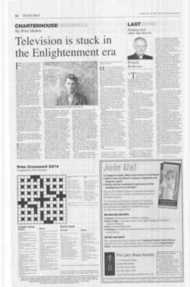Page 7, 10th February 2006
Page 7

Report an error
Noticed an error on this page?If you've noticed an error in this article please click here to report it.
Tags
Share
Related articles
African diary
By David McLaurin
Afew days after getting back from Kampala, the parish priest of Ewauso asked me if I would like to visit his far-flung parish. and given that he has a comfortable four-wheel drive with excellent suspension and air conditioning, I decided to risk it. The parish of Ewauso is about 40 miles from end to end and
contains no tarmac roads. Thus the drive that we took, about 60 miles in length, took roughly four hours. This is where the air conditioning came in: you have to keep the windows shut to keep out the dust. If you do not you will be blinded and choked. Most of the time, when you drive into the wind, the dust is behind you; but on several occasions the wind was following us, and then visibility was almost zero.
Ewauso is about 25 miles from Ngong, and is the chief settlement of the area that you see when you stand on top of the Ngong Hills and look away from Nairobi, though from that standpoint you would be forgiven for thinking there was nothing in the Ewauso valley, for it looks completely waterless. Most of the countryside we traversed would. in North America, be classed as desert: rocky, dusty, containing a few stunted trees and bushes, nothing more. But deceptively there are numerous houses tucked away out of sight where the Maasai live, and where there are Maasai there are flocks of goats and cattle. In addition the valley is home to numerous wild animals: gazelles, which bounded past the car, zebra, which kept their distance for the most part, and several clans of giraffes. none of which, alas, showed themselves. All this is possible, of course, because of water, namely the Ewauso River, which isn't really a river at all, but a tiny trickle, as we are now in the driest of dry seasons; besides which, most of the water, which comes down from the highlands, has been piped off to various points around the valley. As we drove through we saw several places where herds of animals patiently awaited their turns to drink. alongside people carrying plastic containers, also waiting to fill up. But for the most part the Ewauso valley looks like Saudi Arabia. and in many areas the very poor grazing has been totally exhausted. Here's a simple fact: the growth of population and the increase in herds (for every Maasai has to have a herd) means that the land can no longer sustain the pastoral way of life. The proof is not simply in the exhausted grass and scrublands of the valley but also in its history of Violence, as Maasai has fought Kikuyu over the diminishing natural resources.
Another fact that struck me was this: here we were, less than 60 miles from Nairobi, which looks like a modern city, and people were living as they have always lived. As we neared the town of Ewauso, people were walking to market carrying their wares — a 2530 mile walk is nothing to them. (There is no public transport.) Their dress too shows no concession to modernity: one watches two Maasai in their red blankets crossing the plain, with Mount Longonot in the distance, and one realises that this is a timeless scene. The same can be said for the morons „the young warriors preparing for their final initiation, who live apart in their special manyattas, and who walk the roads wearing red body paint and very little else. This is the Africa of Rider Haggard, surely? More on Ewauso next week.
Fr David McLaurin is a missionary priest in Kenya
blog comments powered by Disqus

















